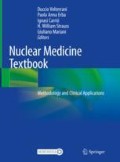Abstract
The formation of CT images involves measurement of the X-ray transmission profile through a patient over a large number of views. Each profile is acquired by means of a fan-shaped X-ray beam that penetrates the body. The X-rays exiting the scanned patient’s body are recorded by a detector arc, generally consisting of 800–1000 detector elements, referred to as a detector row. Each projection of detector’s record (transmission profile) is a view at one position (angle) of the X-ray source. Multiple angular profiles are collected during one complete rotation of the X-ray tube around the patient, which are used to reconstruct the CT image (basically a square matrix of voxel) of the internal organs and tissues for each complete rotation of the X-ray source.
Access this chapter
Tax calculation will be finalised at checkout
Purchases are for personal use only
References
Hounsfield GN. Computed medical imaging. Med Phys. 1980;7:283–90.
Lell MM, et al. Evolution in computed tomography, the battle of speed and dose. Invest Radiol. 2015;50(9):629–44.
Shefer E, et al. State of the art of CT detectors and sources: a literature review. Curr Radiol Rep. 2013;1:76–91.
Mahesh M. MDCT physics: the basics: technology, image quality and radiation dose. Philadelphia, PA: Lippincott Williams & Wilkins; 2012.
Mikla VI. Medical imaging technology. Amsterdam: Elsevier; 2013.
Lecoq P. Development of new scintillators for medical applications. Nuclear Instruments and Methods in Physics Research. 2016;809:130–9.
Duan X. Electronic noise in CT detectors: impact on image noise and artifacts. AJR Am J Roentegenol. 2013;201:W626–32.
Vogtmeier G, et al. Two-dimensional anti-scatter grids for computed tomography detectors. Proc. SPIE 6913, Medical Imaging 2008: Physics of Medical Imaging, 691359, 2008.
Melnyk R, Boudry J, Liu X, Adamak M. Anti-scatter grid evaluation for wide-cone CT. Proc. SPIE 9033, Medical Imaging 2014: Physics of Medical Imaging, 90332P, 2014.
Hu H. Multi-slice helical CT: scan and reconstruction. Med Phys. 1999;26(1):5.
Ulzheimer S, Flohr T. Multislice CT: current technology and future developments. In: Reiser M, Becker C, Nikolaou K, Glazer G, editors. Multislice CT. Medical radiology. Berlin: Springer; 2009.
Pannu HK, Flohr TG, Corl FM, Fishman EK. Current concepts in multi-detector row CT evaluation of the coronary arteries: principles, techniques, and anatomy. Radiographics. 2003;23(Suppl 1):S111–25.
Panetta D. Advances in X-rays detectors for clinical and preclinical Computed Tomography. Nucl Instrum Methods Phys Res Sect A. 2016;809:2–12.
Mayo-Smith WW. How I do it: managing radiation dose in CT. Radiology. 2014;273:657–72.
Goldman LW. Principles of CT: multislice CT. J Nucl Med Technol. 2008;36:57–68.
Geyer LL. State of the art: iterative CT reconstruction techniques. Radiology. 2015;276:339–57.
Beister M, Kolditz D, Kalender WA. Iterative reconstruction methods in X-rays CT. Phys Med. 2012;28:94e108.
American Association of Physicists in Medicine. Report No. 096 – the measurement, reporting, and management of radiation dose in CT. College Park, MD: One Physics Ellipse; 2008. p. 20740–3846.
Brenner DJ. Effective dose: a flawed concept that could and should be replaced. Br J Radiol. 2008;81:521–3.
Huettel SA, Song AW, McCarthy G. Functional magnetic resonance imaging. Sunderland, MA: Sinauer Associates; 2008. p. 49.
Liang Z-P, Lauterbur PC. Principles of magnetic resonance imaging – a signal processing perspective. In: Huettel SA, Song AW, McCarthy G, editors. Functional magnetic resonance imaging. Sunderland, MA: Sinauer Associates; 2008. p. 61.
Gibby WA. Basic principles of magnetic resonance imaging. Neurosurg Clin N Am. 2005;16:1–64.
Hanson LG, Groth T (Trans.). Introduction to magnetic resonance imaging techniques. Lyngby: Technical University of Denmark; 2009.
Taylor JR, Zafiratos CD, Dubson MA. Modern physics for scientist and engineers. Boston, MA: Addison-Wesley; 2003. p. 301–3.. ISBN-13: 978-0138057152; ISBN-10: 013805715X.
Hanson LG. Is quantum mechanics necessary for understanding magnetic resonance? Concepts Mag Reson Part A. 2008;32A(5):329–40.
van Geuns RJM, et al. Basic principles of magnetic resonance imaging. Prog Cardiovasc Dis. 1999;42(2):149–56.
Grover VPB, Tognarelli JM, Crossey MME, Cox IJ, Taylor-Robinson SD, McPhail MJW. Magnetic resonance imaging: principles and techniques: lessons for clinicians. J Clin Exp Hepatol. 2015;5(3):246–55.
Hodgson RJ. The basic science of MRI. Orthopaed Trauma. 2011;25(2):119–30.
Bitar R, et al. MR pulse sequences: what every radiologist wants to know but is afraid to ask. Radiographics. 2006;26:513–37.
Kagawa T, et al. Basic principles of magnetic resonance imaging for beginner oral and maxillofacial radiologists. Oral Radiol. 2017;33:92–100.
Graves MJ, Zhu C. Basic principles of magnetic resonance imaging. In: Trivedi R, Saba L, Suri J, editors. 3D imaging technologies in atherosclerosis. Boston, MA: Springer; 2015.
McRobbie D, Moore E, Graves M, Prince M. Let’s talk technical: MR equipment. In: MRI from picture to proton. Cambridge: Cambridge University Press; 2006. p. 167–91.
Sammet S. Magnetic resonance safety. Abdom Radiol (New York). 2016;41(3):444–51.
Weidman EK, Dean KE, Rivera W, Loftus ML, Stokes TW, Min RJ. MRI safety: a report of current practice and advancements in patient preparation and screening. Clin Imaging. 2015;39(6):935–7.
van Osch MJP, Webb AG. Safety of ultra-high field MRI: what are the specific risks? Curr Radiol Rep. 2014;2:61.
Author information
Authors and Affiliations
Corresponding author
Editor information
Editors and Affiliations
Rights and permissions
Copyright information
© 2019 Springer Nature Switzerland AG
About this chapter
Cite this chapter
Bracco, C., Regge, D., Stasi, M., Gabelloni, M., Neri, E. (2019). Principles of CT and MR imaging. In: Volterrani, D., Erba, P.A., Carrió, I., Strauss, H.W., Mariani, G. (eds) Nuclear Medicine Textbook. Springer, Cham. https://doi.org/10.1007/978-3-319-95564-3_8
Download citation
DOI: https://doi.org/10.1007/978-3-319-95564-3_8
Published:
Publisher Name: Springer, Cham
Print ISBN: 978-3-319-95563-6
Online ISBN: 978-3-319-95564-3
eBook Packages: MedicineMedicine (R0)

